For American Science, The Next Four Years Look To Be Challenging. The Newly Inaugurated President Trump,

For American science, the next four years look to be challenging. The newly inaugurated President Trump, and many of his Cabinet picks, have repeatedly cast doubt upon the reality of human-made climate change, questioned the repeatedly proven safety of vaccines. Since the inauguration, the administration has already frozen grants and contracts by the Environmental Protection Agency and gagged researchers at the US Department of Agriculture. Many scientists are asking themselves: What can I do?
And the answer from a newly formed group called 314 Action is: Get elected.

The organization, named after the first three digits of pi, is a political action committee that was created to support scientists in running for office. It’s the science version of Emily’s List, which focuses on pro-choice female candidates, or VoteVets, which backs war veterans. “A lot of scientists traditionally feel that science is above politics but we’re seeing that politics is not above getting involved in science,” says founder Shaughnessy Naughton.
“We’re losing, and the only way to stop that is to get more people with scientific backgrounds at the table.”
(Continue Reading)
More Posts from Maevetheeuropan and Others
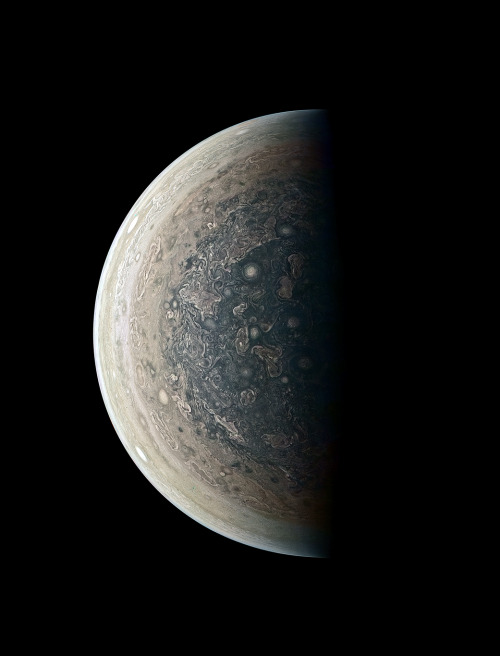
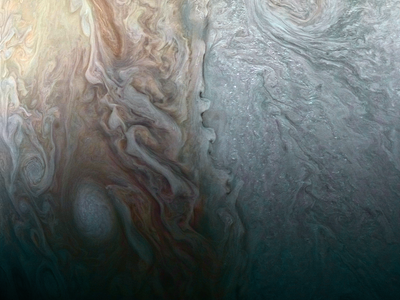



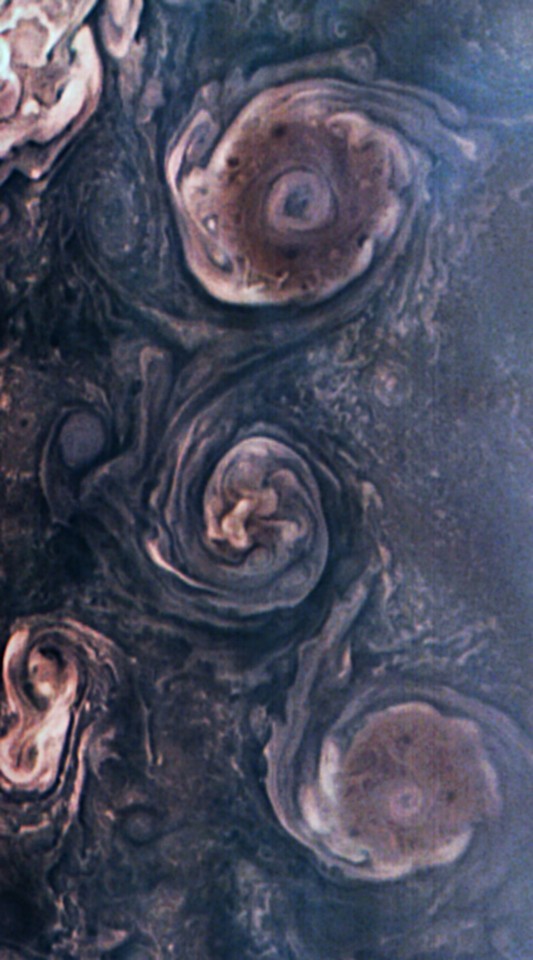



Images of Jupiter taken by JunoCam on NASA’s Juno spacecraft.

Mission Juno
Juno is a NASA spacecraft. It is exploring the planet Jupiter. Juno launched from Earth in 2011. It reached Jupiter in 2016. That was a five-year trip!
The name “Juno” comes from stories told by the Romans long ago. In the stories, Juno was the wife of Jupiter. Jupiter hid behind clouds so no one could see him causing trouble. But Juno could see through the clouds.
Juno has science tools to study Jupiter’s atmosphere. (The atmosphere is the layer of gases around a planet.) Juno will take the first pictures of Jupiter’s poles. The spacecraft will study the lights around Jupiter’s north and south poles, too.
Juno will help scientists understand how Jupiter was made. The spacecraft will help them learn how Jupiter has changed, too. The new discoveries can help us understand more about our solar system.
Sound of Jupiter’s Magnetosphere: Click here
Credit: NASA / JPL-Caltech / Mission Juno / Jason Major / Luca Fornaciari / Gerald Eichstädt
Largest Batch of Earth-size, Habitable Zone Planets
Our Spitzer Space Telescope has revealed the first known system of seven Earth-size planets around a single star. Three of these planets are firmly located in an area called the habitable zone, where liquid water is most likely to exist on a rocky planet.
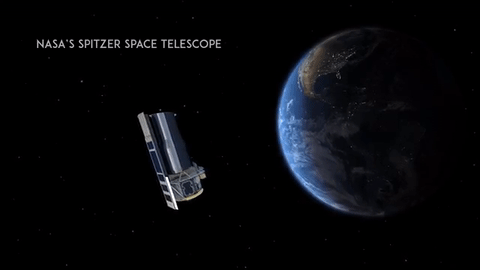
This exoplanet system is called TRAPPIST-1, named for The Transiting Planets and Planetesimals Small Telescope (TRAPPIST) in Chile. In May 2016, researchers using TRAPPIST announced they had discovered three planets in the system.

Assisted by several ground-based telescopes, Spitzer confirmed the existence of two of these planets and discovered five additional ones, increasing the number of known planets in the system to seven.
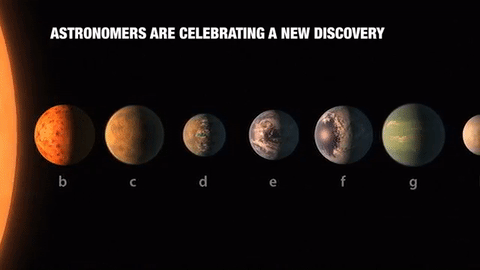
This is the FIRST time three terrestrial planets have been found in the habitable zone of a star, and this is the FIRST time we have been able to measure both the masses and the radius for habitable zone Earth-sized planets.
All of these seven planets could have liquid water, key to life as we know it, under the right atmospheric conditions, but the chances are highest with the three in the habitable zone.

At about 40 light-years (235 trillion miles) from Earth, the system of planets is relatively close to us, in the constellation Aquarius. Because they are located outside of our solar system, these planets are scientifically known as exoplanets. To clarify, exoplanets are planets outside our solar system that orbit a sun-like star.

In this animation, you can see the planets orbiting the star, with the green area representing the famous habitable zone, defined as the range of distance to the star for which an Earth-like planet is the most likely to harbor abundant liquid water on its surface. Planets e, f and g fall in the habitable zone of the star.
Using Spitzer data, the team precisely measured the sizes of the seven planets and developed first estimates of the masses of six of them. The mass of the seventh and farthest exoplanet has not yet been estimated.

For comparison…if our sun was the size of a basketball, the TRAPPIST-1 star would be the size of a golf ball.
Based on their densities, all of the TRAPPIST-1 planets are likely to be rocky. Further observations will not only help determine whether they are rich in water, but also possibly reveal whether any could have liquid water on their surfaces.
The sun at the center of this system is classified as an ultra-cool dwarf and is so cool that liquid water could survive on planets orbiting very close to it, closer than is possible on planets in our solar system. All seven of the TRAPPIST-1 planetary orbits are closer to their host star than Mercury is to our sun.

The planets also are very close to each other. How close? Well, if a person was standing on one of the planet’s surface, they could gaze up and potentially see geological features or clouds of neighboring worlds, which would sometimes appear larger than the moon in Earth’s sky.

The planets may also be tidally-locked to their star, which means the same side of the planet is always facing the star, therefore each side is either perpetual day or night. This could mean they have weather patterns totally unlike those on Earth, such as strong wind blowing from the day side to the night side, and extreme temperature changes.

Because most TRAPPIST-1 planets are likely to be rocky, and they are very close to one another, scientists view the Galilean moons of Jupiter – lo, Europa, Callisto, Ganymede – as good comparisons in our solar system. All of these moons are also tidally locked to Jupiter. The TRAPPIST-1 star is only slightly wider than Jupiter, yet much warmer.
How Did the Spitzer Space Telescope Detect this System?
Spitzer, an infrared telescope that trails Earth as it orbits the sun, was well-suited for studying TRAPPIST-1 because the star glows brightest in infrared light, whose wavelengths are longer than the eye can see. Spitzer is uniquely positioned in its orbit to observe enough crossing (aka transits) of the planets in front of the host star to reveal the complex architecture of the system.

Every time a planet passes by, or transits, a star, it blocks out some light. Spitzer measured the dips in light and based on how big the dip, you can determine the size of the planet. The timing of the transits tells you how long it takes for the planet to orbit the star.

The TRAPPIST-1 system provides one of the best opportunities in the next decade to study the atmospheres around Earth-size planets. Spitzer, Hubble and Kepler will help astronomers plan for follow-up studies using our upcoming James Webb Space Telescope, launching in 2018. With much greater sensitivity, Webb will be able to detect the chemical fingerprints of water, methane, oxygen, ozone and other components of a planet’s atmosphere.
At 40 light-years away, humans won’t be visiting this system in person anytime soon…that said…this poster can help us imagine what it would be like:

Make sure to follow us on Tumblr for your regular dose of space: http://nasa.tumblr.com
Solar System: Things to Know This Week
There’s even more to Mars.

1. Batten Down the Hatches
Good news for future astronauts: scientists are closer to being able to predict when global dust storms will strike the Red Planet. The winds there don’t carry nearly the same force that was shown in the movie “The Martian,” but the dust lofted by storms can still wreak havoc on people and machines, as well as reduce available solar energy. Recent studies indicate a big storm may be brewing during the next few months.
+ Get the full forecast

2. Where No Rover Has Gone Before
Our Opportunity Mars rover will drive down an ancient gully that may have been carved by liquid water. Several spacecraft at Mars have observed such channels from a distance, but this will be the first up-close exploration. Opportunity will also, for the first time, enter the interior of Endeavour Crater, where it has worked for the last five years. All this is part of a two-year extended mission that began Oct. 1, the latest in a series of extensions going back to the end of Opportunity’s prime mission in April 2004. Opportunity landed on Mars in January of that year, on a mission planned to last 90 Martian days (92.4 Earth days). More than 12 Earth years later, it’s still rolling.
+ Follow along + See other recent pictures from Endeavour Crater

3. An Uphill Climb
Opportunity isn’t the only NASA Mars rover getting a mission extension. On the other side of the planet, the Curiosity rover is driving and collecting samples amid some of the most scenic landscapes ever visited on Mars. Curiosity’s two-year mission extension also began Oct. 1. It’s driving toward uphill destinations, including a ridge capped with material rich in the iron-oxide mineral hematite, about a mile-and-a-half (two-and-a-half kilometers) ahead. Beyond that, there’s an exposure of clay-rich bedrock. These are key exploration sites on lower Mount Sharp, which is a layered, Mount-Rainier-size mound where Curiosity is investigating evidence of ancient, water-rich environments that contrast with the harsh, dry conditions on the surface of Mars today.
+ Learn more

4. Keep a Sharp Lookout
Meanwhile, the Mars Reconnaissance Orbiter continues its watch on the Red Planet from above. The mission team has just released a massive new collection of super-high-resolution images of the Martian surface.
+ Take a look

5. 20/20 Vision for the 2020 Rover
In the year 2020, Opportunity and Curiosity will be joined by a new mobile laboratory on Mars. In the past week, we tested new “eyes” for that mission. The Mars 2020 rover’s Lander Vision System helped guide the rocket to a precise landing at a predesignated target. The system can direct the craft toward a safe landing at its primary target site or divert touchdown toward better terrain if there are hazards in the approaching target area.
+ Get details
Discover the full list of 10 things to know about our solar system this week HERE.
Make sure to follow us on Tumblr for your regular dose of space: http://nasa.tumblr.com
omfg I wanna buy this as a poster


Do not go gentle into that good night. Rage, rage against the dying of the light.

Shadow
The US’s GOES-16 weather satellite (still in its testing/non-operational phase) sent back this series of photos taken every 5 minutes today, showing the shadow of the moon marching across the continent. Video shared originally here:
https://twitter.com/UWSSEC/status/899707692364836866
http://www.ssec.wisc.edu
-JBB



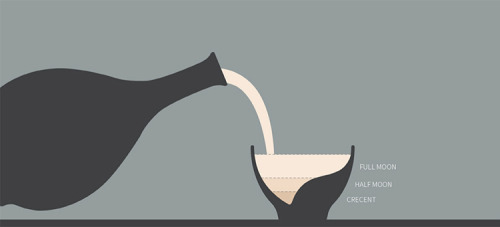



Moon Glass: A Ceramic Cup That Showcases the Different Phases of the Moon the More You Drink From It
South Korean design studio Tale Co., Ltd. has created an ingenious ceramic liquor called the Moon Glass, which displays different phases of the moon as you drink from it. The adorable glasses are available to purchase on their website.

Scientists invented fabric that makes electricity from motion and sunlight. To create the fabric, researchers at Georgia Tech wove together solar cell fibers with materials that generate power from movement. It could be used in “tents, curtains, or wearable garments,” meaning we’d virtually never be without power. Source

Glittering Frisbee Galaxy: This image from Hubble’s shows a section of a spiral galaxy located about 50 million light-years from Earth. We tend to think of spiral galaxies as massive and roughly circular celestial bodies, so this glittering oval does not immediately appear to fit the visual bill. What’s going on? Imagine a spiral galaxy as a circular frisbee spinning gently in space. When we see it face on, our observations reveal a spectacular amount of detail and structure. However, the galaxy frisbee is very nearly edge-on with respect to Earth, giving it an appearance that is more oval than circular. The spiral arms, which curve out from the galaxy’s dense core, can just about be seen. Although spiral galaxies might appear static with their picturesque shapes frozen in space, this is very far from the truth. The stars in these dramatic spiral configurations are constantly moving as they orbit around the galaxy’s core, with those on the inside making the orbit faster than those sitting further out. This makes the formation and continued existence of a spiral galaxy’s arms something of a cosmic puzzle, because the arms wrapped around the spinning core should become wound tighter and tighter as time goes on - but this is not what we see. This is known as the winding problem. Image credit: ESA/Hubble & NASA For more information on this image, visit: https://go.nasa.gov/2niODGL
-
 lurkiestvoid liked this · 1 year ago
lurkiestvoid liked this · 1 year ago -
 mineswine liked this · 1 year ago
mineswine liked this · 1 year ago -
 meowing-at-u liked this · 2 years ago
meowing-at-u liked this · 2 years ago -
 jackrabbitem liked this · 3 years ago
jackrabbitem liked this · 3 years ago -
 nyktos-philos liked this · 4 years ago
nyktos-philos liked this · 4 years ago -
 ruby-seadragon liked this · 5 years ago
ruby-seadragon liked this · 5 years ago -
 stayfm reblogged this · 5 years ago
stayfm reblogged this · 5 years ago -
 shane-anigans liked this · 5 years ago
shane-anigans liked this · 5 years ago -
 kiracatvria reblogged this · 6 years ago
kiracatvria reblogged this · 6 years ago -
 nyame002 liked this · 6 years ago
nyame002 liked this · 6 years ago -
 gryphalcon85 reblogged this · 6 years ago
gryphalcon85 reblogged this · 6 years ago -
 bunnyearrings liked this · 6 years ago
bunnyearrings liked this · 6 years ago -
 tortuefleur liked this · 6 years ago
tortuefleur liked this · 6 years ago -
 hier-und-dar reblogged this · 6 years ago
hier-und-dar reblogged this · 6 years ago -
 onlyoneovaryohgress liked this · 6 years ago
onlyoneovaryohgress liked this · 6 years ago -
 docfgeek reblogged this · 6 years ago
docfgeek reblogged this · 6 years ago -
 docfgeek liked this · 6 years ago
docfgeek liked this · 6 years ago -
 samiholloway reblogged this · 6 years ago
samiholloway reblogged this · 6 years ago -
 katyraloki liked this · 6 years ago
katyraloki liked this · 6 years ago -
 demonofthelight reblogged this · 6 years ago
demonofthelight reblogged this · 6 years ago -
 rs-likes reblogged this · 6 years ago
rs-likes reblogged this · 6 years ago -
 tehwereferret liked this · 6 years ago
tehwereferret liked this · 6 years ago -
 arodoka liked this · 6 years ago
arodoka liked this · 6 years ago -
 ultigom reblogged this · 6 years ago
ultigom reblogged this · 6 years ago -
 jengerxbread reblogged this · 6 years ago
jengerxbread reblogged this · 6 years ago -
 vosh-daemon reblogged this · 6 years ago
vosh-daemon reblogged this · 6 years ago -
 c-ology reblogged this · 6 years ago
c-ology reblogged this · 6 years ago -
 c-ology liked this · 6 years ago
c-ology liked this · 6 years ago -
 v01dgalaxy reblogged this · 6 years ago
v01dgalaxy reblogged this · 6 years ago -
 v01dgalaxy liked this · 6 years ago
v01dgalaxy liked this · 6 years ago -
 mugwomps reblogged this · 6 years ago
mugwomps reblogged this · 6 years ago -
 mugwomps liked this · 6 years ago
mugwomps liked this · 6 years ago -
 louismirage reblogged this · 7 years ago
louismirage reblogged this · 7 years ago -
 daily-foragers liked this · 7 years ago
daily-foragers liked this · 7 years ago